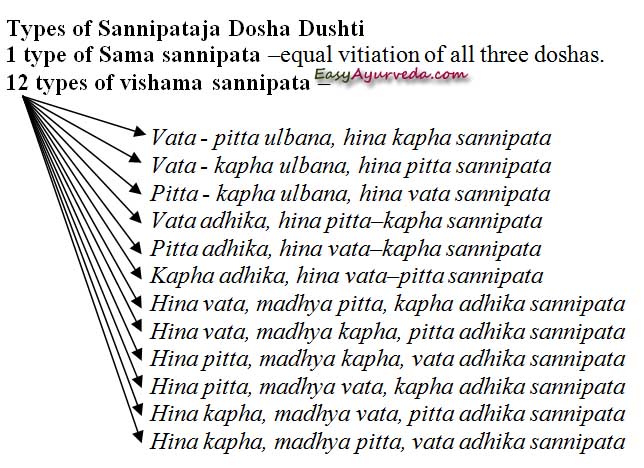Sannipataja Dosha Dushti – When All Three Doshas Are Imbalanced
Article by Dr Raghuram Y.S. MD (Ay) & Dr Manasa, B.A.M.S
Sannipataja Dosha Dushti is a type of vitiation of dosha(s) in which there is simultaneous vitiation of all the three doshas. These three simultaneously vitiated doshas take part in the causation of certain diseases and such diseases are called as sannipataja or tridoshaja vyadhis.
Related Reading – Samsarga and Sannipata Dosha Dushti
Table of Contents
Sannipataja Dosha Dushti
Sannipataja Dosha Dushti (triple dosha vitiation), its characteristic features
Triple dosha vitiation is also called as tridoshaja dosha dusti.
The disease formed from triple vitiation of doshas is also called samsargaja vyadhi.
Example,
Sannipataja Murcha, Sannipataja Unmada, Sannipataja Chardi etc.
Read related: Samsargaja Dosha Dushti
Causes
Causes (nidanas) – the etiological factors responsible for vitiation of all the three doshas will be jointly responsible for simultaneous vitiation of all the three doshas. The patient would have exposed to etiological factors for vitiation of all the three vata, pitta and kapha in tridoshaja (fever caused due to simultaneous vitiation of all vata, pitta and kapha).
Symptoms
Symptoms (lakshanas) – the symptoms of all the three doshas involved in the causation of disease will be available in the disease caused by their combined vitiation.
Example, in sannipataj jwara,
- feeling of cold, pain in bones, joints, head, drowsiness, delirium etc symptoms are caused due to vata,
- burning sensation, spitting of blood contaminated with pitta, appearance of skin eruptions, brownish black and red colored skin patches, suppuration, formation of pus etc symptoms are caused due to pitta,
- cough, breathlessness, feel of cold, heaviness of the abdomen etc symptoms are formed due to kapha
Prognosis
Prognosis – the diseases caused by triple vitiation of doshas is said to be incurable.
Treatment
Treatment (chikitsa) – while treating the diseases caused by triple dosh vitiation, all three doshas should be taken into consideration and should be treated to pacify all the three doshas in such a way that the treatment for one dosha doesn’t contrast the treatment of the other two doshas.
Nature of vitiation of doshas in sannipataj dushti – in sannipataja dushti one dosha may be vitiated severely whereas the other doshas may also be vitiated but less prominently. Alternatively, all three doshas may be vitiated in equal strengths. The symptoms, prognosis and treatment should be according to the strength of the vitiated dosha(s).
Example, in fever caused due to simultaneous vitiation of all the three doshas, vata may be vitiated severely in comparison to pitta and kapha, kapha may be the least vitiated one whereas pitta might be moderately vitiated. Such a fever will be called as Vata Pradhana Sannipataja Jwara. The name indicates the predominant and less predominant doshas involved in the disease formation. In this case of sannipataj fever since vata is mentioned first, it should be the main dosha to be predominantly vitiated among all the three doshas involved in the causation of fever.
In this condition, the treatment should be given to all the three doshas focusing mainly on the main vitiated dosha (vata) and also to pacify the less vitiated doshas (pita and kapha) such that the treatments and diet are mutually not antagonistic.
Similarly tridoshaja fever might be caused by equal vitiation of all three vata, pitta and kapha. The symptoms, prognosis and treatment will be alike.

Types of Sannipataja Dosha Dushti
Types of triple vitiation of doshas
Triple dosha vitiation manifests in 13 different forms depending on permutations and combinations of dosha vitiation.
1 type of Sama sannipata – Sama Sannipata is of 1 type wherein there is equal vitiation of all three doshas.
12 types of vishama sannipata – Vishama Sannipata are of 12 types wherein there is unequal vitiation (vitiation in unequal proportions) of all three doshas involved in triple vitiation. The 12 types of triple vitiation are as explained below –
Vata – pitta ulbana, hina kapha sannipata – In this type of vishama sannipata, vata and pitta are highly vitiated in equal proportions, whereas Kapha is vitiated in less proportion
Vata – kapha ulbana, hina pitta sannipata – Here, vata and kapha are highly vitiated in equal proportions, whereas pitta is vitiated in less proportion
Pitta – kapha ulbana, hina vata sannipata – Here, pitta and kapha are highly vitiated in equal proportions, whereas vata is vitiated in less proportion
Vata adhika, hina pitta – kapha sannipata – Here, vata is highly vitiated, whereas pitta and kapha are vitiated in less proportion and in equal proportions
Pitta adhika, hina vata – kapha sannipata – Pitta is highly vitiated, whereas vata and kapha are vitiated in less and equal proportions.
Kapha adhika, hina vata – pitta sannipata – Kapha is highly vitiated, whereas vata and pitta are vitiated in less and equal proportions.
Hina vata, madhya pitta, shleshma adhika sannipata – Vata is less vitiated, pitta is moderately vitiated and kapha is highly vitiated
Hina vata, madhya kapha, pitta adhika sannipata – Vata is less vitiated, kapha is moderately vitiated and pitta is highly vitiated
Hina pitta, madhya kapha, vata adhika sannipata – Pitta is less vitiated, kapha is moderately vitiated and vata is highly vitiated
Hina pitta, madhya vata, kapha adhika sannipata – Pitta is less vitiated, vata is moderately vitiated and kapha is highly vitiated
Hina kapha, madhya vata, pitta adhika sannipata – Kapha is less vitiated, vata is moderately vitiated and pitta is highly vitiated
Hina kapha, madhya pitta, vata adhika sannipata – Kapha is less vitiated, pitta is moderately vitiated and vata is highly vitiated
Example
Taking example of Sannipataja fever –
In sama and vishama sannipataja fever the treatment line is different. Sama Sannipata may be treated on the lines of sannipata jwara. In vishama sannipataja jwara focus to reduce the most vitiated dosha is given while addressing all the three doshas. In either case the general treatment lineup of sannipataja jwara explained in Ayurvedic texts should be followed. This shows that all three doshas are equally important in a sannipata from the treatment point of view.
This concept has been explained in the context of sannipataja fever(but may be considered in other diseases also).
Just Before Finishing –
The knowledge of such type of minute pathological variations happening with respect to each dosha in relation to other two doshas involved in triple vitiation helps a physician to diagnose and understand the disease accurately and minutely and to plan the treatment protocols in a comprehensive way.
Click to Consult Dr Raghuram Y.S. MD (Ayu) – Email / Skype










